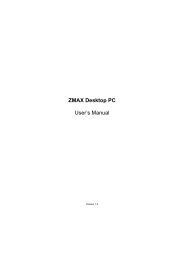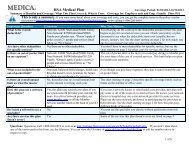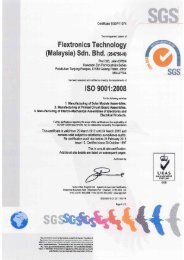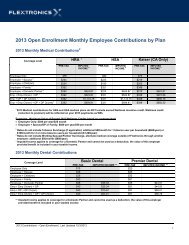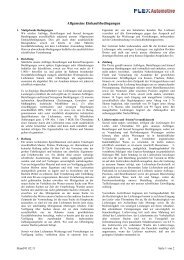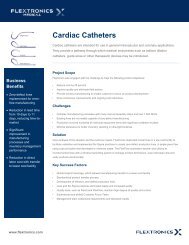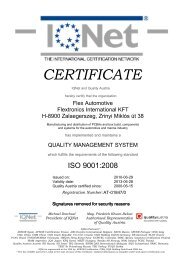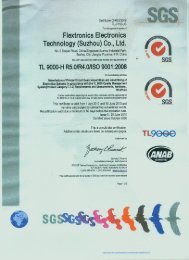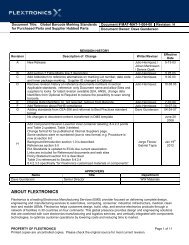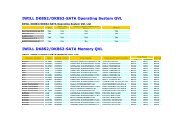IWILL DN800-SATA/DN800-L Motherboard User's ... - Flextronics
IWILL DN800-SATA/DN800-L Motherboard User's ... - Flextronics
IWILL DN800-SATA/DN800-L Motherboard User's ... - Flextronics
You also want an ePaper? Increase the reach of your titles
YUMPU automatically turns print PDFs into web optimized ePapers that Google loves.
<strong>IWILL</strong><br />
<strong>DN800</strong>-<strong>SATA</strong>/<strong>DN800</strong>-L<br />
<strong>Motherboard</strong><br />
User’s Manual<br />
FB25633000<br />
Overview Hardware Installation BIOS Setup
<strong>DN800</strong>-<strong>SATA</strong>/-L <strong>Motherboard</strong> <strong>IWILL</strong><br />
2 <strong>IWILL</strong> <strong>DN800</strong>-<strong>SATA</strong>/-L Series
<strong>IWILL</strong> User’s Manual<br />
Disclaimer<br />
The manufacturer makes no representations or warranties regarding the contents of this manual<br />
and specifically disclaims any implied warranties of merchantability or fitness for any particular<br />
purpose. Furthermore, the manufacturer reserves the right to revise this publication or make<br />
changes in the specifications of the product described within it at any time without notice and<br />
without obligation to notify any person of such revision or change.<br />
Trademarks<br />
Microsoft and Windows are registered trademarks of Microsoft Corp. Intel and Xeon are<br />
registered trademarks of Intel Corporation. Other product names used in this manual are the<br />
properties of their respective owners and are acknowledged.<br />
Copyright<br />
This publication, including all photographs, illustrations and software, is protected under<br />
international copyright laws, with all rights reserved. Neither this manual, nor any of the material<br />
contained here in, may be reproduced without the express written consent of the manufacturer.<br />
<strong>IWILL</strong> ©Copyright 2004<br />
All produce specs are subject to change without prior notice. The actual specs will be<br />
according to the actual product.<br />
<strong>IWILL</strong> <strong>DN800</strong>-<strong>SATA</strong>/-L Series 3
<strong>DN800</strong>-<strong>SATA</strong>/-L <strong>Motherboard</strong> <strong>IWILL</strong><br />
Table of Contents<br />
CHAPTER 1 OVERVIEW ...........................................................................................................................6<br />
<strong>DN800</strong>-<strong>SATA</strong>/<strong>DN800</strong>-L PACKAGE CONTENT.............................................................................................7<br />
SAFETY NOTICE...........................................................................................................................................8<br />
GETTING HELP ..........................................................................................................................................10<br />
<strong>DN800</strong>-<strong>SATA</strong>/<strong>DN800</strong>-L SPECIFICATIONS.................................................................................................11<br />
CHAPTER 2 COMPONENTS AND JUMPER SETTING......................................................................13<br />
MOTHERBOARD LAYOUT:..........................................................................................................................14<br />
COMPONENTS LIST ....................................................................................................................................15<br />
JUMPER SETTING .......................................................................................................................................16<br />
JP1: Clear CMOS Header ...................................................................................................................16<br />
JP3; JB3A: FSB Jumper ......................................................................................................................17<br />
JP16: BIOS Protection Jumper............................................................................................................17<br />
J42 Case Open Pin Header..................................................................................................................17<br />
J57: Front Audio Jumper .....................................................................................................................18<br />
REAR PANEL I/O PORTS.............................................................................................................................19<br />
ADDITIONAL I/O CONNECTORS .................................................................................................................21<br />
J32: COM2 Header..............................................................................................................................21<br />
J43: Front Panel Switch Header..........................................................................................................21<br />
J45: IrDA Connector ...........................................................................................................................23<br />
J46: Color Connector ..........................................................................................................................24<br />
J48: SMBus Connector ........................................................................................................................24<br />
SERIAL ATA CONNECTOR ..........................................................................................................................25<br />
USB HEADER............................................................................................................................................27<br />
J60A, J60B: IEEE 1394 (FIREWIRE) HEADER..........................................................................................28<br />
<strong>DN800</strong>-<strong>SATA</strong>/-L POWER SUPPLY..............................................................................................................29<br />
IDE AND FLOPPY CONNECTORS ................................................................................................................30<br />
CHAPTER 3 HARDWARE INSTALLATION .........................................................................................32<br />
MOTHERBOARD INSTALLATION .................................................................................................................33<br />
INSTALLING THE CPU AND HEATSINK PROCEDURES..................................................................................34<br />
MEMORY INSTALLATION PROCEDURE........................................................................................................41<br />
INSTALLING EXPANSION CARDS ................................................................................................................43<br />
POWERING ON YOUR SYSTEM ....................................................................................................................45<br />
4 <strong>IWILL</strong> <strong>DN800</strong>-<strong>SATA</strong>/-L Series
<strong>IWILL</strong> User’s Manual<br />
CHAPTER 4 BIOS SETUP ........................................................................................................................46<br />
BIOS SETUP..............................................................................................................................................47<br />
USING THE BIOS SETUP UTILITY ..............................................................................................................49<br />
MAIN MENU ..............................................................................................................................................51<br />
ADVANCED MENU .....................................................................................................................................52<br />
BOOT MENU ..............................................................................................................................................53<br />
BOOT SETTING CONFIGURATION SUBMENU...............................................................................................54<br />
EXIT MENU................................................................................................................................................56<br />
CHAPTER 5 OS AND DRIVERS INSTALLATION ...............................................................................57<br />
OS INSTALLATION .....................................................................................................................................58<br />
DRIVERS INSTALLATION ............................................................................................................................59<br />
<strong>IWILL</strong> <strong>DN800</strong>-<strong>SATA</strong>/-L Series 5
<strong>DN800</strong>-<strong>SATA</strong>/-L <strong>Motherboard</strong> <strong>IWILL</strong><br />
Chapter 1 Overview<br />
6 <strong>IWILL</strong> <strong>DN800</strong>-<strong>SATA</strong>/-L Series
<strong>IWILL</strong> User’s Manual<br />
1. <strong>DN800</strong>-<strong>SATA</strong>/<strong>DN800</strong>-L <strong>Motherboard</strong><br />
� Professional workstation system board<br />
2. Three jumper caps<br />
� Extra caps in case original caps get lost<br />
3. One Power Installation CD<br />
<strong>DN800</strong>-<strong>SATA</strong>/<strong>DN800</strong>-L Package Content<br />
� Includes support software, drivers and bundled software utilities.<br />
4. Rear panel I/O shield<br />
� Covers the area around the rear panel I/O ports when the board is installed in a<br />
system housing.<br />
5. Two sets of <strong>SATA</strong> cables<br />
� Connector cable for onboard <strong>SATA</strong> connectors. (<strong>DN800</strong>-L only one set)<br />
6. Two ATA-66/100 IDE cables<br />
� Connects IDE devices to one of the onboard IDE connectors.<br />
7. One floppy disk drive cable<br />
� Connects floppy disk drives to the onboard floppy disk connector.<br />
8. Two Hat Springs for CPU cooler<br />
� Sustain and connect between CPU cooler and chassis<br />
9. One iron backplate<br />
� The iron backplate connects the motherboard and chassis, and sustain the mass of<br />
CPU heatsink.<br />
10. Two CPU Plastic backplates<br />
� It can fix the third party CPU heatsink. Please refer to Chapter 3 for detail<br />
information.<br />
11. Two heatsink retention modules<br />
� It can buckle up the CPU heatsink. Please refer to Chapter 3 for detail information.<br />
<strong>IWILL</strong> <strong>DN800</strong>-<strong>SATA</strong>/-L Series 7
<strong>DN800</strong>-<strong>SATA</strong>/-L <strong>Motherboard</strong> <strong>IWILL</strong><br />
GENERAL SAFETY PRECAUTIONS<br />
Safety Notice<br />
� Keep the area around the Server clean and free of clutter.<br />
� Servers weigh a lot. When lifting the system, two people should lift slowly from<br />
opposite ends with their feet spread out to distribute the weight. Always keep your<br />
back straight and lift with your legs.<br />
� Place the chassis top cover and any system components that have been removed<br />
away from the system or on a table so that they won’t accidentally be stepped on.<br />
� While working on the system, do not wear loose items such as neckties and<br />
unbuttoned shirtsleeves. They can come into contact with electrical circuits or get<br />
pulled into a cooling fan.<br />
� Remove any jewelry or metal objects from your body, which are excellent metal<br />
conductors and can create short circuits and harm you if they come into contact with<br />
printed circuit boards or areas where power is present.<br />
ESD PRECAUTIONS<br />
Electrostatic discharge (ESD) is generated by two objects with different electrical charges<br />
coming into contact with each other. An electrical discharge is created to neutralize this<br />
difference, which can damage electronic components and printed circuit boards. The<br />
following measures are generally sufficient to neutralize this difference before contact is<br />
made to protect your equipment from ESD:<br />
� Use a grounded wrist strap designed to prevent static discharge.<br />
� Keep all components and printed circuit boards (PCBs) in their antistatic bags until<br />
ready for use.<br />
� Touch a grounded metal object before removing the board from the antistatic bag.<br />
� Do not let components or PCBs come into contact with your clothing, which may<br />
retain a charge even if you are wearing a wrist strap.<br />
� Handle a board by its edges only; do not touch its components, peripheral chips,<br />
memory modules or contacts.<br />
8 <strong>IWILL</strong> <strong>DN800</strong>-<strong>SATA</strong>/-L Series
<strong>IWILL</strong> Overview<br />
� When handling chips or modules, avoid touching their pins.<br />
� Put the motherboard and peripherals back into their antistatic bags when not in use.<br />
� For grounding purposes, make sure your computer chassis provides excellent<br />
conductivity between the power supply, the case, the mounting fasteners and the<br />
motherboard.<br />
� After accessing the inside of the system, close the system back up and secure it to<br />
the rack unit with the retention screws after ensuring that all connections have been<br />
made.<br />
OPERATING PRECAUTIONS<br />
� Check package contents<br />
� Missing or damaging accessories<br />
Please contact your vendor immediately<br />
� <strong>Motherboard</strong> damage<br />
Please contact your vendor immediately<br />
� Prepare minimum system components<br />
� Intel Xeon @800MHz FSB Processor<br />
� At least one Registered DDR2 memory module<br />
� At least one <strong>SATA</strong> or IDE HDD<br />
� EPS12V Power Supply with 460W or above<br />
Important: You must have enough system integration knowledge before<br />
the installation<br />
<strong>IWILL</strong> <strong>DN800</strong>-<strong>SATA</strong>/-L Series 9
<strong>DN800</strong>-<strong>SATA</strong>/-L <strong>Motherboard</strong> <strong>IWILL</strong><br />
Getting Help<br />
If a problem arises with your system during Installation or Operation, you should first ask<br />
your dealer for help as they have most likely configured your system. They generally<br />
have the best grasp of your issues and the fastest response for your symptoms. If your<br />
dealer is near your location, it is recommended that you first bring your system to them to<br />
have it serviced instead of attempting to solve the problem yourself.<br />
If those options don't work for you, <strong>IWILL</strong> also provides some helpful resources to help<br />
you.<br />
1. Visit <strong>IWILL</strong>® website at Http://www.iwill.net and navigate to this product’s page<br />
which contain links to product updates such as Jumper settings or BIOS updates.<br />
2. The FAQ (Frequently Asked Questions) sections in the <strong>IWILL</strong> website are often<br />
helpful since other users often have the same questions.<br />
3. Email us at: support@iwill.net and we will try to answer your questions within 5<br />
business days.<br />
10 <strong>IWILL</strong> <strong>DN800</strong>-<strong>SATA</strong>/-L Series
<strong>IWILL</strong> Overview<br />
<strong>DN800</strong>-<strong>SATA</strong>/<strong>DN800</strong>-L Specifications<br />
Processor � Intel® Dual Xeon Socket 604 CPUs<br />
� Supports 800MHz FSB<br />
Chipset � Intel E7525 Chipset MCH<br />
� Intel Hance Rapids<br />
� Winbond 83627 THF<br />
Memory � 4 DIMMs for 240-pin DDR2 DIMM sockets<br />
� Uses Registered DDR2 with ECC or Non-ECC memory<br />
� Supports total system memory size of up to 8GB<br />
On-Board<br />
LAN<br />
� Intel GbE Controller<br />
� One RJ-45 connectors for GbE<br />
� Support PME<br />
USB � 4 x external USB 2.0 ports by NEC USB controllor<br />
� 4 x internal USB 2.0 headers by HR<br />
IEEE-1394 � 3 x IEEE-1394 ports ( 1x external port, 2x internal headers)<br />
Serial ATA<br />
Expansion<br />
Slots<br />
Internal I/O<br />
connector<br />
IDE Bus<br />
� 4 Serial ATA ports supported by Silicon Image with RAID 0, 1, 10<br />
(<strong>DN800</strong>-<strong>SATA</strong> Only)<br />
� 2 Serial ATA ports supported by HR<br />
� Support Adaptec Host RAID<br />
� Support hot swap<br />
� One PCI Express x16 slot<br />
� One PCI Express x8 slot<br />
� Three PCI 32/33 slots<br />
� 1 x 34-pin Floppy Connector<br />
� 4-pin CD-In and Aux-In audio input connector<br />
� 2x 40-pin IDE connectors, supports up to four (4) Enhanced IDE<br />
devices<br />
� Dual Channel Master Mode<br />
� Ultra DMA 100/66/33<br />
<strong>IWILL</strong> <strong>DN800</strong>-<strong>SATA</strong>/-L Series 11
<strong>DN800</strong>-<strong>SATA</strong>/-L <strong>Motherboard</strong> <strong>IWILL</strong><br />
External I/O<br />
Internal I/O<br />
System BIOS<br />
System Management<br />
Form Factor<br />
� PS/2 mouse and keyboard connectors<br />
� 1 x UART 16550 serial port (COM1)<br />
� 1 x 25-pin parallel port with ECP/EPP support<br />
� 4 x USB 2.0 ports<br />
� 1 x Gigabit Ethernet LAN RJ-45 port<br />
� 1 x IEEE-1394 port<br />
� 1 x S/PDIF Out<br />
� Rear Out and Center Out<br />
� Audio Phone Jacks - Line Out, Mic In, Line-In.<br />
� 1 x UART by 9-pin header<br />
� 1 x Smbus connector<br />
� 1 x WOL connector<br />
� 1 x IR connector<br />
� AMI BIOS<br />
� Flash write protection by BIOS and one jumper<br />
� ACPI 1.1<br />
� APM 1.2<br />
� Support ACPI S1<br />
� Support ASF2.0<br />
� Hardware Monitor control by ADT-7460<br />
� Fan speed control method: DC FAN<br />
� Support AC power failure<br />
� ATX form factor<br />
� 12’’x10’’<br />
� EPS 12V power connectors (24 pin + 8 pin)<br />
12 <strong>IWILL</strong> <strong>DN800</strong>-<strong>SATA</strong>/-L Series
<strong>IWILL</strong> Components and Jumper Setting<br />
Chapter 2 Components and Jumper Setting<br />
<strong>IWILL</strong> <strong>DN800</strong>-<strong>SATA</strong>/-L Series 13
<strong>DN800</strong>-<strong>SATA</strong>/-L <strong>Motherboard</strong> <strong>IWILL</strong><br />
<strong>Motherboard</strong> Layout:<br />
14 <strong>IWILL</strong> <strong>DN800</strong>-<strong>SATA</strong>/-L Series
<strong>IWILL</strong> Components and Jumper Setting<br />
Components List<br />
CPU1; CPU2 Intel Xeon Socket604 Processor<br />
Primary; Secondary IDE Driver Connectors<br />
Floppy Floppy Disk Driver Connector<br />
PCI Slots PCI-Express x16, x8 Slots; PCI 32/33<br />
DIMM A1~B2 Memory Socket for DDR2 Memory<br />
JP1 Clear CMOS Jumper<br />
JP3, JP3A FSB Jumper<br />
JP16 BIOS Protect Jumper<br />
J32 COM2 Port<br />
J34, J34A USB 2.0 Headers<br />
J42 Case Open Pin Header<br />
J43 Front Panel Connector<br />
J45 IrDA Connector<br />
J46 WOL Connector<br />
J48 SMBus Connector<br />
J53 AUX-IN<br />
J54 CD-IN<br />
J57B Audio Jumper<br />
J58, J58A, J58B, J58C, J58D, J58E Serial ATA Connectors<br />
J60A, J60B IEEE-1394 Headers<br />
<strong>IWILL</strong> <strong>DN800</strong>-<strong>SATA</strong>/-L Series 15
<strong>DN800</strong>-<strong>SATA</strong>/-L <strong>Motherboard</strong> <strong>IWILL</strong><br />
2<br />
1<br />
Jumper Setting<br />
JP1: Clear CMOS Header<br />
The onboard button cell battery powers the CMOS RAM. It contains all the BIOS setup<br />
information. Keep the jumper connected to pins 1-2 (Default) to retain the RTC data as<br />
shown below.<br />
3<br />
Under certain circumstances, you will need to reset system settings. Follow these<br />
instructions to clear the CMOS RTC data:<br />
1. Turn off the computer.<br />
2. Short pins 2 and 3 with a jumper for a few seconds.<br />
3. Replace the jumper to pins 1 and 2.<br />
4. Turn on your computer by pressing the power-on button.<br />
5. Hold down during boot and select either or<br />
in the “Exit” section. Then go through the BIOS setup<br />
to re-enter user preferences.<br />
1-2 2-3<br />
Normal (Default) Clear CMOS<br />
16 <strong>IWILL</strong> <strong>DN800</strong>-<strong>SATA</strong>/-L Series
<strong>IWILL</strong> Components and Jumper Setting<br />
JP3; JB3A: FSB Jumper<br />
This header lets you set your memory speed. Depend on the memory you choose, please<br />
adjust this jumper in order to optimize your memory utilize.<br />
3<br />
2<br />
1<br />
JP16: BIOS Protection Jumper<br />
This jumper protects the system from unnecessary updating or flashing of the BIOS. It<br />
secures the BIOS therefore prevents accidental overwriting of the data stored in flash<br />
memory.<br />
JP16<br />
3 2 1<br />
1-2 By Soft (default)<br />
2-3 Lock<br />
Open Unlock<br />
J42 Case Open Pin Header<br />
Case Open is a security function. This can detect whether the chassis (case) had been<br />
opened or not. If the case had been opened, the open record would show on the screen<br />
until you delete this message.<br />
1<br />
FSB JP3A JP3 MEMORY<br />
800MHz (Default) Pin1-2 Pin1-2 DDRII-400<br />
Setting J42<br />
Open Disable<br />
Close Enable<br />
<strong>IWILL</strong> <strong>DN800</strong>-<strong>SATA</strong>/-L Series 17
<strong>DN800</strong>-<strong>SATA</strong>/-L <strong>Motherboard</strong> <strong>IWILL</strong><br />
J57: Front Audio Jumper<br />
This header lets you enable or disable the function of the front audio connector.<br />
J57 W/O FRONT WITH FRONT<br />
AUDIO AUDIO<br />
CONNECTOR CONNECTOR<br />
5-6 SHORT OPEN<br />
9-10 SHORT OPEN<br />
18 <strong>IWILL</strong> <strong>DN800</strong>-<strong>SATA</strong>/-L Series
<strong>IWILL</strong> Components and Jumper Setting<br />
Rear Panel I/O Ports<br />
This is an illustration of the Mainboard rear I/O port array<br />
PS/2 Mouse Connector (6-pin Female)<br />
The system will direct IRQ12 to the PS/2 mouse if one is detected. If no mouse is<br />
detected, IRQ12 will be free for expansion cards to use.<br />
PS/2 Keyboard Connector (6-pin Female)<br />
This connection is for standard keyboards using a PS/2 (mini DIN) plug. This connector<br />
will not accept standard AT size (large DIN) keyboard plugs. You may need a DIN to<br />
mini DIN adapter for standard AT keyboards.<br />
Parallel Printer Connector (25-pin Female)<br />
You can enable the parallel port and choose an IRQ through the BIOS. You can choose<br />
between ECP and EPP support through the BIOS setup.<br />
Serial Port (COM1) Connector (9-pin Male)<br />
The COM1 serial port can be used for pointing devices or other serial devices.<br />
Universal Serial Bus Ports (4-pin Female)<br />
Four onboard external USB 2.0 ports are available for connecting USB devices. Refer to<br />
USB 2.0 Ports & Header for more information.<br />
<strong>IWILL</strong> <strong>DN800</strong>-<strong>SATA</strong>/-L Series 19
<strong>DN800</strong>-<strong>SATA</strong>/-L <strong>Motherboard</strong> <strong>IWILL</strong><br />
IEEE 1394/ FireWire Connector (6-pin Male)<br />
You have one (1) onboard IEEE 1394 connector port for connecting FireWire devices.<br />
Refer to IEEE 1394 Ports & Header for more information.<br />
Onboard LAN Port (RJ-45)<br />
This Mainboard uses Intel Gigabit Ethernet Controller. Refer to the Onboard LAN User<br />
Guide for further information.<br />
Audio Jacks (Phone Jacks)<br />
The interface is supported by the onboard Analog Device AD1980. It has 3 phone jacks<br />
for Line-Out, Microphone In, and Line-In.<br />
S/PDIF Port<br />
<strong>DN800</strong>-<strong>SATA</strong>/ <strong>DN800</strong>-L also provide the S/PDIF out, Rear Out, and Center Out<br />
function.<br />
20 <strong>IWILL</strong> <strong>DN800</strong>-<strong>SATA</strong>/-L Series
<strong>IWILL</strong> Components and Jumper Setting<br />
Additional I/O Connectors<br />
The Mainboard also contains connectors for adding additional ports and devices to the<br />
Mainboard.<br />
J32: COM2 Header<br />
The COM2 Port Bracket Connector lets you add an additional serial port, to which you can<br />
connect peripherals such as serial modems and pointing devices.<br />
Pin1 DCD# Pin2 RXD<br />
Pin3 TXD Pin4 DTR#<br />
Pin5 CON Pin6 DSR#<br />
Pin7 RTS# Pin8 CTS#<br />
Pin9 RI# Pin10 NC<br />
J43: Front Panel Switch Header<br />
Reset Switch (2-pin RST)<br />
This 2-pin connector connects to the chassis-mounted reset switch for<br />
rebooting your computer without turning your power switch off and on.<br />
This is a preferred method of rebooting your system to prolong the life<br />
of your system’s power supply.<br />
Hard Disk Activity LED (2-pin HDD_LED)<br />
This connector supplies power to the chassis's HDD/IDE activity LED.<br />
Read and Write activity by devices connected to the Primary or<br />
Secondary IDE connectors will cause the front panel LED to light up.<br />
ACPI LED<br />
ACPI function allows the system to enter or resume from the Suspend<br />
mode. If your system chassis does not have this button, the same<br />
function may be performed from your OS; if it is supported.<br />
<strong>IWILL</strong> <strong>DN800</strong>-<strong>SATA</strong>/-L Series 21
<strong>DN800</strong>-<strong>SATA</strong>/-L <strong>Motherboard</strong> <strong>IWILL</strong><br />
Power On Switch<br />
This switch connects to the system’s Power button allowing you to<br />
power on and off the system. You can configure the system to use the<br />
keyboard or mouse to power-on the system. You can also configure<br />
the system to respond to power restoration after a power outage occurs.<br />
These functions can be configured by making appropriate settings in<br />
the Integrated Peripherals submenu (“Super IO Device” field) of the<br />
BIOS.<br />
Speaker Connector<br />
This connects to the PC speaker installed in the system chassis.<br />
Power LED Connector<br />
This connector connects to the system’s Power LED. When the<br />
system’s power is on, this LED will light.<br />
22 <strong>IWILL</strong> <strong>DN800</strong>-<strong>SATA</strong>/-L Series
<strong>IWILL</strong> Components and Jumper Setting<br />
J45: IrDA Connector<br />
Function<br />
The IrDA connector is for wireless connectivity between your computer and<br />
peripheral devices. The IRDA (Infrared Data Association) specification supports<br />
data transfers of 115K baud at a distance of 1 meter. It supports both IrDA and<br />
ASKIR infrared port modules.<br />
Connecting the IrDA Cable<br />
To use the IrDA function, follow the steps below.<br />
1. Connect your IrDA cable to connector J45.<br />
2. Set the “UART Mode Select” field to the type of IrDA standard supported by<br />
your IrDA peripheral/device. For better transmission of data, your IrDA<br />
peripheral device must be within a 30 o angle and within a distance of 1 meter.<br />
You may not use IrDA and the COM 2 serial port at the same time. If you are<br />
using the COM 2 serial port, make sure to set the “UART Mode Select” field to<br />
Normal.<br />
3. Set the “RxD, TxD Active”, “IR Transmission Delay”, “UR2<br />
Duplex Mode” and “Use IR Pins” fields appropriately.<br />
Driver Installation<br />
You may need to install the proper drivers in your operating system to use the IrDA<br />
function. Refer to your operating system’s manual or documentation for more<br />
information.<br />
<strong>IWILL</strong> <strong>DN800</strong>-<strong>SATA</strong>/-L Series 23
<strong>DN800</strong>-<strong>SATA</strong>/-L <strong>Motherboard</strong> <strong>IWILL</strong><br />
J46: WOL Connector<br />
Function<br />
This connector lets you attach a managed network adapter to the motherboard via a<br />
Wake-on-LAN cable. When the system is off, the managed network adapter uses an<br />
alternate power source to monitor the network. If it receives a wake-up packet from<br />
the server the system is remotely and automatically powered up.<br />
J48: SMBus Connector<br />
Function<br />
The SMBus (System Management Bus) connector is used to connect SMBus devices.<br />
It is a multiple device bus that allows multiple chips to connect to the same bus and<br />
enable each one to act as a master by initiating data transfer.<br />
24 <strong>IWILL</strong> <strong>DN800</strong>-<strong>SATA</strong>/-L Series
<strong>IWILL</strong> Components and Jumper Setting<br />
Serial ATA Connector<br />
J58, J58A Serial ATA Connector<br />
<strong>DN800</strong>-<strong>SATA</strong>/-L supports up to 2 <strong>SATA</strong> devices each with data transfer rates of<br />
150MB/s. Two Serial ATA ports are supported by HR with RAID 0 and 1. RAID stands<br />
for "Redundant Array of Independent Devices" and provides different levels of safety,<br />
redundancy and performance.<br />
This Mainboard features two Serial ATA ports for two Serial ATA devices.<br />
J58B, J58C, J58D, J58E Serial ATA Connector (<strong>DN800</strong>-<strong>SATA</strong> ONLY)<br />
SILICON IMAGE CHIPSET AND SERIAL ATA<br />
The Serial version of this Mainboard is equipped with an integrated Silicon Image<br />
Sil3114 Serial ATA chipset. This chipset supports up to 4 <strong>SATA</strong> devices at transfer rates<br />
of up to 150MB/s.<br />
The Silicon Image Chipset also supports RAID configurations. RAID stands for<br />
"Redundant Array of Independent Devices" and provides different levels of safety,<br />
redundancy and performance. This chipset supports RAID 0, 1, and 10, which are defined<br />
as follows:<br />
<strong>IWILL</strong> <strong>DN800</strong>-<strong>SATA</strong>/-L Series 25
<strong>DN800</strong>-<strong>SATA</strong>/-L <strong>Motherboard</strong> <strong>IWILL</strong><br />
RAID Type Description<br />
RAID 0<br />
RAID 1<br />
RAID 10<br />
Striping: high performance, designed to connect multiple drives to act as<br />
one<br />
Mirroring: writes data to two drives at once in case one drive fails, the<br />
other one will be a complete replica and can continue on.<br />
Combination of RAID 0 and 1: over 4 drives, The drives are split in half<br />
and striped together, and the 2 new striped drives are then mirrored.<br />
26 <strong>IWILL</strong> <strong>DN800</strong>-<strong>SATA</strong>/-L Series
<strong>IWILL</strong> Components and Jumper Setting<br />
USB Header<br />
J34, J34A: USB 2.0 PORTS AND HEADER<br />
<strong>DN800</strong>-<strong>SATA</strong>/-L supports eight USB 2.0 ports. Four USB 2.0 ports locate at the rear<br />
panel. They are supported by NEC chipset. Four USB 2.0 headers are for the front panel.<br />
USB 2.0 supports transfer rates of up to 480MB/s.<br />
<strong>IWILL</strong> <strong>DN800</strong>-<strong>SATA</strong>/-L Series 27
<strong>DN800</strong>-<strong>SATA</strong>/-L <strong>Motherboard</strong> <strong>IWILL</strong><br />
J60A, J60B: IEEE 1394 (FireWire) Header<br />
This Mainboard features an integrated Texas Instrument TSB43AB23 chip which<br />
supports three (3) IEEE 1394 (Firewire) ports. IEEE 1394 (FireWire) supports transfer<br />
rates of up to 400MB/s. One port is installed on the on-board I/O array, and two header is<br />
for external installation.<br />
28 <strong>IWILL</strong> <strong>DN800</strong>-<strong>SATA</strong>/-L Series
<strong>IWILL</strong> Components and Jumper Setting<br />
EPS12V POWER CONNECTORS<br />
<strong>DN800</strong>-<strong>SATA</strong>/-L Power Supply<br />
There are two power connectors on the motherboard of the required EPS 12V power<br />
supply. These are not standard ATX connectors. <strong>DN800</strong>-<strong>SATA</strong>/-L needs a minimum<br />
460-watt EPS 12V power supply that complies with the Intel Xeon processor power<br />
supply design guidelines. Find the proper orientation of the connectors and push down<br />
firmly to make sure that the pins are aligned (the connector will only insert properly when<br />
properly aligned). The 8-pin connector is a dedicated power connector to supply power<br />
for the CPUs.<br />
EPS12V PSU Only<br />
<strong>IWILL</strong> <strong>DN800</strong>-<strong>SATA</strong>/-L Series 29
<strong>DN800</strong>-<strong>SATA</strong>/-L <strong>Motherboard</strong> <strong>IWILL</strong><br />
PRIMARY IDE CONNECTORS<br />
IDE and Floppy Connectors<br />
The two 40-pin IDE connectors (primary and secondary channels) support 80-conductor<br />
IDE ribbon cables. Connect the single connector end to the Mainboard. Then, connect the<br />
two connectors at the other end to your IDE device(s). If you connect two hard disks to<br />
the same cable, you must set the second drive as a Slave through its jumper settings.<br />
Refer to the IDE device's documentation for the specific jumper settings. (Pin 20 is<br />
removed to prevent the connector from being inserted in the wrong orientation when<br />
using ribbon cables with pin 20 plugged in). The BIOS supports Ultra DMA 33/66/100.<br />
IMPORTANT<br />
Ribbon cables should always be connected with the red<br />
stripe on the Pin 1 side of the connector. IDE ribbon<br />
cables must be less than 46 cm (18 inches) long, with the<br />
second drive connector no more than 15 cm (6 inches)<br />
away from the first connector.<br />
FLOPPY DISK DRIVE CONNECTOR<br />
Pin1<br />
This 34-pin connector supports the standard floppy disk drive ribbon cable. Connect the<br />
single connector end to the Mainboard. Then, plug the other end of the ribbon into the<br />
floppy drive. Make sure you align the Pin 1 on the connector with the Pin 1 alignments<br />
on the Mainboard and the floppy drive.<br />
30 <strong>IWILL</strong> <strong>DN800</strong>-<strong>SATA</strong>/-L Series
<strong>IWILL</strong> Components and Jumper Setting<br />
CPU/ SYSTEM FAN CONNECTORS<br />
There are five 3-pin fan connectors in the Mainboard. Two fans are used for CPU1 and<br />
CPU2; three fans are for system and back. These connectors support cooling fans of<br />
500mA (6W) or less. All fan drive current minimum are must over 1.5V. Depending on<br />
the fan manufacturer, the wiring and plug may be different. Connect the fan’s plug to the<br />
Mainboard with respect to the polarity of the fan connector.<br />
WARNING<br />
The CPU and/or motherboard will overheat if there is not enough airflow across the CPU<br />
and onboard heatsink. Damage may occur to the motherboard and/or the CPU fan if these<br />
pins are incorrectly used. These are NOT jumpers; DO NOT place jumper caps over these<br />
pins.<br />
<strong>IWILL</strong> <strong>DN800</strong>-<strong>SATA</strong>/-L Series 31
<strong>DN800</strong>-<strong>SATA</strong>/-L <strong>Motherboard</strong> <strong>IWILL</strong><br />
Chapter 3 Hardware Installation<br />
32 <strong>IWILL</strong> <strong>DN800</strong>-<strong>SATA</strong>/-L Series
<strong>IWILL</strong> Hardware installation<br />
<strong>Motherboard</strong> Installation<br />
This section explains the basic requirements for installing the motherboard in a<br />
system housing or “chassis”. Since housing designs vary widely, you will need to<br />
consult the housing documentation for specific information.<br />
To install the motherboard in a system housing, you will need to do the following:<br />
• Install a rear panel I/O shield<br />
• Attach the board to the housing<br />
• Connect leads from the housing’s front panel<br />
• Connect other internal system components.<br />
<strong>Motherboard</strong> Installation Procedure<br />
The motherboard requires installing the supplied CPU Hat Spring to mount the heat<br />
sink retention mechanisms. Refer to the CPU Installation section in this chapter for<br />
details.<br />
If the housing you are using normally stands vertically, place the open housing on its<br />
side before you start.<br />
To install the motherboard, please follow the steps below.<br />
1. Review any instructions that came with the system housing and prepare the<br />
necessary mounting hardware that came with it.<br />
2. Identify the mounting holes on the motherboard and confirm that the housing has<br />
standoffs that match them.<br />
3. Install the rear panel I/O shield in the housing’s I/O panel opening.<br />
4. Place the motherboard in the housing and align the mounting holes to the<br />
standoffs of the housing’s motherboard mounting plate. Make sure all of the rear<br />
I/O ports are properly aligned with the openings of the I/O panel.<br />
5. Secure the motherboard to the housing by inserting mounting screws in all the<br />
holes.<br />
<strong>IWILL</strong> <strong>DN800</strong>-<strong>SATA</strong>/-L Series 33
<strong>DN800</strong>-<strong>SATA</strong>/-L <strong>Motherboard</strong> <strong>IWILL</strong><br />
Installing the CPU and Heatsink Procedures<br />
<strong>IWILL</strong> <strong>DN800</strong>-<strong>SATA</strong>/-L support Intel Xeon @FSB800 MHz processor. We only<br />
recommend using the Intel Original heatsink kit. CEK (Common Enabling Kit) is<br />
specially designed for the Intel latest Xeon. For installing CEK, please follow direction as<br />
below.<br />
Step 1 -- Before you install the heatsink, please check whether the attached Hat<br />
Springs fasten well to the back of this motherboard or not.<br />
Step 2-- Position the attached silver standoffs for the special-designed iron plate.<br />
34 <strong>IWILL</strong> <strong>DN800</strong>-<strong>SATA</strong>/-L Series
<strong>IWILL</strong> Hardware installation<br />
Step 3--- Screw this plate to the chassis you will use to install this motherboard. Please<br />
position the case mounting hole of this plate to the chassis, and use four copper standoffs<br />
to fix the iron-plate to the chassis. Match the rest screw holes and install the standoffs that<br />
come with the chassis.<br />
Step 4--- Please align the system board and backplate together and make sure<br />
matching the heatsink, system board, and backplate holes in the same position.<br />
<strong>IWILL</strong> <strong>DN800</strong>-<strong>SATA</strong>/-L Series 35
<strong>DN800</strong>-<strong>SATA</strong>/-L <strong>Motherboard</strong> <strong>IWILL</strong><br />
Step 5-- Raise the retaining lever of the processor locking mechanism to a<br />
perpendicular position.<br />
Raise the retaining lever Raise the socket lever to<br />
the vertical position<br />
Step 6--Align the processor to the socket by matching the Pin 1 corner of the socket<br />
(marked with a triangle) to the Pin 1 corner on the Socket 604 (marked by a<br />
triangular hole in the Pin 1 corner).<br />
Align the Pin 1 corners<br />
36 <strong>IWILL</strong> <strong>DN800</strong>-<strong>SATA</strong>/-L Series
<strong>IWILL</strong> Hardware installation<br />
Step 7--Carefully insert the Xeon processor in the socket receptacles, taking care not<br />
to bend any pins.<br />
Insert the processor<br />
Step 8--Lower the locking mechanism’s retaining lever and secure it in place to<br />
secure the processor in the socket. Grasp the processor by the edges and gently pull<br />
upwards to insure it is properly inserted. The processor shouldn’t move.<br />
Secure the CPU retaining<br />
lever<br />
<strong>IWILL</strong> <strong>DN800</strong>-<strong>SATA</strong>/-L Series 37
<strong>DN800</strong>-<strong>SATA</strong>/-L <strong>Motherboard</strong> <strong>IWILL</strong><br />
Step 9--Apply all of the TIM in the applicator to the center of the square heat<br />
spreader plate in the middle of the CPU. Do not spread the TIM around. When you<br />
place the heatsink on top of the CPU the material will disperse evenly.<br />
Apply all of the thermal<br />
interface material to the<br />
center of the processor<br />
heater spreader plate<br />
Important: When you only place ONE Intel Xeon processor, please put on the position<br />
of CPU1<br />
38 <strong>IWILL</strong> <strong>DN800</strong>-<strong>SATA</strong>/-L Series
<strong>DN800</strong>-<strong>SATA</strong>/-L <strong>Motherboard</strong> <strong>IWILL</strong><br />
Heatsink Installation Notice<br />
From the third party heatsink<br />
--The rim of heatsink has a fillister, and it needs the retention to fasten it.<br />
1. Put the attached CPU plastic plate to the<br />
back of this motherboard<br />
2. Screw Retention Module on top of this<br />
motherboard<br />
3. Put CPU HeatSink on the top and finish<br />
the installation<br />
40 <strong>IWILL</strong> <strong>DN800</strong>-<strong>SATA</strong>/-L Series
<strong>IWILL</strong> Hardware installation<br />
Installing Memory<br />
Memory Installation Procedure<br />
This Mainboard uses Registered DDR2 Memory with ECC or Non-ECC only. Please be<br />
aware of the difference between DDR and DDR2. DDR modules will NOT compatible<br />
with DDR2 slots. Don’t plug DDR modules into <strong>DN800</strong>-<strong>SATA</strong>/-L memory slots.<br />
IMPORTANT<br />
� Before buying DDR2 (Double Data Rate 2) DIMMs for use with the Mainboard, it is<br />
recommended that you consult your local reseller for the best and most compatible<br />
memory to use.<br />
� This Mainboard only supports Registered DDR2 compliant modules.<br />
� To ensure compatibility, only use DIMM pairs of the same exact type and size and<br />
made by the same company.<br />
IO Shield<br />
CPU<br />
One DDR2 Module DIMM B2 (1)<br />
Two DDR2 Modules DIMM B2, A2<br />
Four DDR2 Modules DIMM B2, A2; B1, A1<br />
(1) We strongly recommend that you always install a pair of<br />
DDR memory in order to take the full advantage of dual<br />
channel.<br />
<strong>IWILL</strong> <strong>DN800</strong>-<strong>SATA</strong>/-L Series 41
<strong>IWILL</strong> Hardware installation<br />
Installing Expansion Cards<br />
<strong>DN800</strong>-<strong>SATA</strong>/<strong>DN800</strong>-L has the PCI-Express and PCI slots that can be used for any<br />
expansion cards, such as LAN, SCSI, or Riser cards. <strong>DN800</strong>-<strong>SATA</strong>/<strong>DN800</strong>-L provides<br />
two PCI-Express slots (one with x16 bandwidth; another with x8 bandwidth) for the<br />
high-end expansion card choices. Please be aware of the difference between the<br />
PCI-Express and PCI or AGP slots. Before you install any expansion cards, please read<br />
carefully the instruction provided by the card manufacturers.<br />
The procedures of installation method<br />
1. Insert the PCI card into the correct slot on the Mainboard, pushing down with your<br />
thumbs evenly on both sides of the card.<br />
2. Secure the card on the slot with the screw you removed above.<br />
3. Assign IRQs for PCI expansion card: An IRQ number is automatically assigned to PCI<br />
expansion card. In the PCI bus design, the BIOS automatically assigns an IRQ to a PCI<br />
slot that contains a card requiring an IRQ.<br />
Important:<br />
You can follow the below chart to plug your PCI-Express Expansion Card.<br />
Card Interoperability<br />
Slot x1 x4 x8 x16<br />
Card<br />
x1 Yes Yes Yes Yes<br />
x4 No Yes Yes Yes<br />
x8 No No Yes Yes<br />
x16 No No No Yes<br />
<strong>IWILL</strong> <strong>DN800</strong>-<strong>SATA</strong>/-L Series 43
<strong>DN800</strong>-<strong>SATA</strong>/-L <strong>Motherboard</strong> <strong>IWILL</strong><br />
WARNING<br />
Please completely power OFF your power supply when adding or removing any<br />
expansion cards or other system components. Failure to do so may cause severe damage<br />
to both your Mainboard and expansion cards.<br />
Important: <strong>DN800</strong>-<strong>SATA</strong>/-L provides a PCI-Express x16 slot for graphic use. It provides<br />
the higher performance and greater bandwidth than the traditional AGP slot.<br />
<strong>DN800</strong>-<strong>SATA</strong>/-L does not support AGP slot, so please choose the graphic card with<br />
PCI-Express interface.<br />
44 <strong>IWILL</strong> <strong>DN800</strong>-<strong>SATA</strong>/-L Series
<strong>IWILL</strong> Hardware installation<br />
Powering on your System<br />
Follow these instructions to power on the computer after you have installed the<br />
Mainboard and all system devices.<br />
1. Be sure that all switches are off (in some systems, Off is marked by “O”).<br />
2. After double-checking all jumper settings and connections, close the system chassis<br />
cover.<br />
3. Connect the power cord to the power cord connector located on the power supply at<br />
the back of your system chassis and plug the power cord into a power outlet that is<br />
equipped with a surge protector.<br />
4. Turn on your devices in the following order:<br />
- Monitor<br />
- System power<br />
For power supplies, you need to switch On the power supply, then press the:<br />
1. Power switch on the front of the chassis the first time you start up the system.<br />
2. The power LED on the front panel of the system case will light up. For power<br />
supplies, the system LED will light up when the power switch is pressed. The monitor<br />
LED may light up after the system’s LED if it complies with “Green” standards or if<br />
it has a power standby feature. The system will first run its “power-on” tests. While<br />
the tests are running, additional messages will appear on the screen. If you do not see<br />
anything on the screen within 30 seconds from the time you turn on the power, the<br />
system may have failed a power-on test. Re-check your jumper settings and<br />
connections. Contact your retailer/dealer for assistance if everything else fails.<br />
3. During power-on, hold down to enter BIOS setup. Follow the instructions in<br />
BIOS for further setup information.<br />
<strong>IWILL</strong> <strong>DN800</strong>-<strong>SATA</strong>/-L Series 45
<strong>DN800</strong>-<strong>SATA</strong>/-L <strong>Motherboard</strong> <strong>IWILL</strong><br />
Chapter 4 BIOS Setup<br />
46 <strong>IWILL</strong> <strong>DN800</strong>-<strong>SATA</strong>/-L Series
<strong>IWILL</strong> BIOS Setup<br />
BIOS Setup<br />
This chapter discusses the AMIBIOS Setup program built into the ROM BIOS. The Setup<br />
program allows users to modify the basic system configuration.<br />
The BIOS is the Basic Input / Output System used in all IBM PC, XT, AT, and PS/2<br />
compatible computers. The AMIBIOS flash chip stores the system parameters, such as<br />
type of disk drives, video displays, etc. in the CMOS. When the computer is turned off, a<br />
back-up battery provides power to the BIOS flash chip, enabling it to retain system<br />
parameters. Each time the computer is powered-on the computer is configured with the<br />
values stored in the BIOS ROM by the system BIOS, which gains control at boot-up.<br />
The AMIBIOS installed in your computer system’s ROM (Read Only Memory) is a<br />
custom version of an industry standard BIOS. The BIOS provides critical low-level<br />
support for standard devices such as disk drives and serial and parallel ports.<br />
STARTING THE BIOS SETUP<br />
The AMIBIOS is immediately activated every time you power on the system. The BIOS<br />
reads the system information contained in the CMOS and begins the process of checking<br />
the system and configuring it. After configuring the system, the BIOS will follow the<br />
Boot Order to seek out an operating system. The BIOS then turns control of the system<br />
over to the operating system.<br />
The CMOS information that determines the system parameters may be changed by<br />
entering the BIOS Setup utility.<br />
1. Power on the System.<br />
Note: Normally, the only visible POST (Power On Self Test) routine is the<br />
memory test.<br />
<strong>IWILL</strong> <strong>DN800</strong>-<strong>SATA</strong>/-L Series 47
<strong>DN800</strong>-<strong>SATA</strong>/-L <strong>Motherboard</strong> <strong>IWILL</strong><br />
2. As the memory is being tested, you can access the BIOS Setup Utility by pressing<br />
the key when “Press < F2> to enter SETUP” appears briefly at the bottom<br />
of the screen.<br />
From the main menu of the BIOS Setup Utility, you can access the other setup screens,<br />
such as the Security and Power menus.<br />
48 <strong>IWILL</strong> <strong>DN800</strong>-<strong>SATA</strong>/-L Series
<strong>IWILL</strong> BIOS Setup<br />
Using the BIOS Setup Utility<br />
Navigating through the BIOS Setup Utility is straightforward. Use the arrow keys to<br />
highlight items, press to select items in menus, and press to quit. The<br />
following table provides more details about how to navigate in the Setup program using<br />
the keyboard.<br />
Up ArrowKey Move to the previous item<br />
Down Arrow Key Move to the next item<br />
Left Arrow Key Move to the previous menu<br />
Right Arrow Key Move to the next menu<br />
key<br />
Key<br />
Key<br />
In the Submenu: Exit the submenu.<br />
In the BIOS main menu: Jump to the Exit Menu<br />
Select the highlighted item. When available, a<br />
pop-up list will display for you to select the<br />
item value or select a submenu<br />
Previous page on Scrollable menus or Jump to<br />
the first interactive item listed<br />
Key<br />
Next page on Scrollable menus or Jump to the<br />
last interactive item listed<br />
Key General Help on Setup navigation keys.<br />
/ Key Change Colors<br />
Key Discard Changes<br />
Key Load Failsafe Defaults<br />
Key Load Optimal Defaults<br />
Key Save and Exit<br />
Home Go to Top of Screen<br />
END Go to Bottom of Screen<br />
ESC Exit<br />
<strong>IWILL</strong> <strong>DN800</strong>-<strong>SATA</strong>/-L Series 49
<strong>DN800</strong>-<strong>SATA</strong>/-L <strong>Motherboard</strong> <strong>IWILL</strong><br />
IMPORTANT<br />
The BIOS does NOT automatically save values that you have modified. If you do not<br />
save your values before you exit the BIOS Setup Utility, all your changes will be lost.<br />
If after making and saving system changes with the BIOS Setup Utility, you discover that<br />
your computer is no longer able to boot, the AMIBIOS supports an override, which will<br />
reset your system to the Failsafe defaults. If that fails, it is possible to manually clear the<br />
present CMOS information through the "Clear CMOS Header" on the motherboard<br />
(Refer to Jumper Settings for more information).<br />
The best advice is to ONLY alter settings that you thoroughly understand. The default<br />
settings have been carefully chosen by AMIBIOS to provide the maximum system<br />
performance and reliability. Even a slight change to the chipset setup may cause potential<br />
and unpredictable failure to the system.<br />
50 <strong>IWILL</strong> <strong>DN800</strong>-<strong>SATA</strong>/-L Series
<strong>IWILL</strong> BIOS Setup<br />
Main Menu<br />
This is the first screen that is displayed when you enter the BIOS Setup Utility. Each tab<br />
lined on the top of the screen represents each different menu. The following picture<br />
shows the main menu. Main menu shows the information of BIOS version, date and ID,<br />
processor type, speed and count, and system size. In addition, system time and date is<br />
adjustable using + / - key or number keys.<br />
Important: Due to the different BIOS versions, this BIOS screen will possibly be not<br />
exactly the same with what you see while you are setting up <strong>DN800</strong>-<strong>SATA</strong>/-L BIOS.<br />
Please read the right description column carefully on your BIOS screen. For any further<br />
setup questions, please contact with our Technology Support staff.<br />
<strong>IWILL</strong> <strong>DN800</strong>-<strong>SATA</strong>/-L Series 51
<strong>DN800</strong>-<strong>SATA</strong>/-L <strong>Motherboard</strong> <strong>IWILL</strong><br />
Advanced Menu<br />
You can make these modifications on the Advanced Menu. Select the Submenus to<br />
modify those settings.<br />
� CPU Configuration<br />
Configure CPU Setting<br />
� IDE Configuration<br />
Configure IDE Setting<br />
� Floppy Configuration<br />
Configure floppy Setting<br />
� SuperIO Configuration<br />
Configure Super IO chipset setting<br />
� Hardware Health Configuration<br />
Monitor Hardware Health<br />
� ACPI Configuration<br />
Configure ACPI Setting<br />
� MPS Configuration<br />
Configure Multi-Processors Table<br />
� PCI-Express Configuration<br />
Configure PCI-Express support<br />
� Remote Access Configuration<br />
Configure Remove Access Setting<br />
� USB Configuration<br />
Configure USB Setting<br />
� Onboard Device Configuration<br />
Configure onboard device, such as Silicon 3114 and NEC USB, Setting<br />
� Performance Setting<br />
52 <strong>IWILL</strong> <strong>DN800</strong>-<strong>SATA</strong>/-L Series
<strong>IWILL</strong> BIOS Setup<br />
Boot Menu<br />
Feature Description<br />
Boot Device Priority Specify the boot device priority sequence<br />
Hard Disk Drives<br />
Removable Drives<br />
CD/DVD Drives<br />
Specify the boot device priority sequence<br />
from available hard drives<br />
Specify the boot device priority sequence<br />
from available removable drives<br />
Specify the boot device priority sequence<br />
from available CD/DVD drives<br />
<strong>IWILL</strong> <strong>DN800</strong>-<strong>SATA</strong>/-L Series 53
<strong>DN800</strong>-<strong>SATA</strong>/-L <strong>Motherboard</strong> <strong>IWILL</strong><br />
Boot Setting Configuration Submenu<br />
Feature Option Description<br />
Quick Boot<br />
Quiet Boot<br />
AddOn ROM Display Mode<br />
Bootup Num-Lock<br />
PS/2 Mouse Support<br />
Typematic Rate<br />
Disabled<br />
Enabled<br />
Disabled<br />
Enabled<br />
Force BIOS<br />
Keep Current<br />
Off<br />
On<br />
Disabled<br />
Enabled<br />
Slow<br />
Fast<br />
Allows BIOS to skip tests<br />
while booting<br />
Disabled: display normal<br />
POST messages<br />
Enabled: display OEM logo<br />
Set display mode for option<br />
ROM<br />
Select power on state for<br />
NumLock<br />
Select<br />
mouse<br />
support for PS/2<br />
Select keyboard typematic<br />
rate<br />
54 <strong>IWILL</strong> <strong>DN800</strong>-<strong>SATA</strong>/-L Series
<strong>IWILL</strong> BIOS Setup<br />
Wait for “F1” if error<br />
Hit ‘DEL’ Message Display<br />
Interrupt 19 Capture<br />
Disabled<br />
Enabled<br />
Disabled<br />
Enabled<br />
Disabled<br />
Enabled<br />
Wait for F1 key to be pressed<br />
if error occurs<br />
Display “Press DEL to run<br />
Setup” in POST<br />
Enabled: allows option<br />
ROMs to trap interrupt 19<br />
<strong>IWILL</strong> <strong>DN800</strong>-<strong>SATA</strong>/-L Series 55
<strong>DN800</strong>-<strong>SATA</strong>/-L <strong>Motherboard</strong> <strong>IWILL</strong><br />
OS Installation<br />
<strong>DN800</strong>-<strong>SATA</strong>/-L can be run on Windows 2000, XP, and Linux (SuSe64, RedHat,<br />
Turbo) system.<br />
<strong>DN800</strong>-<strong>SATA</strong>/-L supports the Intel Extended Memory 64 bit Technology. In order<br />
to run the full advantage of 64 bit, you should install OS with 64 bit architecture.<br />
For the 64 bit OS information, you can go to the below website to find out more<br />
information.<br />
� Contact Microsoft for additional details.<br />
http://www.microsoft.com/presspass/press/2004/feb04/02-17ExtendedTechnologyPR.asp.<br />
� Contact Red Hat for additional details.<br />
http://rhn.redhat.com<br />
� Contact SuSE for additional details.<br />
http://www.suse.com/us/partner/become_partner/technology_partner.html<br />
58 <strong>IWILL</strong> <strong>DN800</strong>-<strong>SATA</strong>/-L Series
<strong>IWILL</strong> OS and Drivers Installation<br />
Drivers Installation<br />
Inside the motherboard package, you could find a Power installation CD. It<br />
contains the required drivers.<br />
Inside the CD, you can find the free software “Acrobat Reader” to help you read<br />
our pdf.file. Besides, this user’s manual will also be placed inside this CD-ROM.<br />
<strong>IWILL</strong> <strong>DN800</strong>-<strong>SATA</strong>/-L Series 59
<strong>DN800</strong>-<strong>SATA</strong>/-L <strong>Motherboard</strong> <strong>IWILL</strong><br />
Please click the Driver Installation option, you can choose below these drivers to<br />
download:<br />
1. Intel INF Driver<br />
2. Audio Driver<br />
3. Intel LAN Driver guide<br />
4. USB 2.0 Driver (for Windows 2000)<br />
5. <strong>SATA</strong> Installation<br />
If you have any question about how to install operation system, please check on<br />
<strong>IWILL</strong> website www.iwill.net or contact with our Technology Supporters. We also<br />
suggest you visit our website for downloading the latest BIOS and drivers<br />
regularly.<br />
60 <strong>IWILL</strong> <strong>DN800</strong>-<strong>SATA</strong>/-L Series



